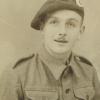This account, produced by kind permission of Maj Gen Dare Wilson, is an extract from his book 'Cordon and Search' the definitive account of 6th Airborne Division's activities in Palestine. Available from Pen and Sword Books.
On 25th April 1946, the Stern Gang carried out an attack which for cold-blooded brutality could hardly have been surpassed.
In the preface to this book reference is made to the absence of bitterness which was shown towards the Jews by those who served with the Division in Palestine. This remark cannot, however, apply to these extremists. No man, whatever his rank, who was serving in the Division on this day will easily forget the feeling of revulsion and frustration which he experienced as a result of this despicable act.
The Division had taken over in Tel Aviv some time previously a car park which was bounded by houses on three sides, and faced the sea on the fourth. The car park was used largely by recreational transport from all formations and units which came into the town on certain afternoons and most evenings. In it was a guard provided by the Lydda Brigade, and which on the night in question came from 5th Parachute Battalion. The object of the guard was primarily to prevent the vehicles, or anything in them, from being stolen, and in order to make their task easier, the park was well surrounded with wire. The strength of the guard on this night was 8 men including 2 NCOs.
At 20:30 hours (after dark), three vehicles stopped at a house opposite to the entrance to the car park, and between 25 and 30 men, dressed in civilian clothes, entered the house. Here they immediately held up the occupants, and unseen from the car park, established fire positions overlooking the guard tents.
Fifteen minutes later a bomb was thrown at the front of the guard tents as a signal for the attack to start. Automatic fire was then directed as a signal for the attack to start. Automatic fire was then directed at the sentries on duty and any soldiers in sight. Those who were not killed had to take cover from the fire which was at very short range. Under the covering fire some twenty or more of the gangsters crossed the road and entered the car park. They entered the first tent in which two soldiers were off duty, and the sergeant of the guard who was unlocking the rifle rack. While shining torches on the two soldiers [Ptes McKay and Gilliard] who were taking cover on the floor of the tent from the fire outside, they shot them with tommy-guns at point-blank range. A burst was also fired at the sergeant who unable to reply and having by chance been missed, fell to the ground, feigning death. While he lay at their feet the arms rack was emptied and all the weapons were stolen. Arms, however, were only a secondary consideration; the object of the raid was mass murder, as rapid and complete as possible. It is not known what happened in the next tent, as both occupants were killed, but they also were unarmed.
Finally, two soldiers of the Division, who came up to the car park during the attack presumably to assist the guard, were also shot.
The casualties to our troops totalled 7, all killed:
Pte John A Gilliard
Pte John Hope
Pte Norman E Knight
Pte Harry Lewis
Pte Hugh S McKay
Pte Alexander Morrison
Pte John H Park
After laying mines to cover their escape, the attackers withdrew into the Yemenite section of the Karton quarter, leaving behind them a trail of blood which suggested that at least one had been hit.
It might be explained here that up to this point the stage had not yet been reached when deliberate attacks on British Army personnel were expected. Thus the defence for this guard in the shape of protective sandbag walls around the tents, gunpits for sentries, and a well-defended gate at the entrance had generally not been adopted. These came late, together with many other additional security measures, as a result of this attack and others which followed. It is too easy to be wise after the event, but by this time the situation had not deteriorated sufficiently to suggest that the defences were in any way inadequate. At least, however, this bitter lesson never had to be relearned.
By Major General Dare Wilson CBE MC
Read More




Latest Comments
There are currently no comments for this content.
Add Comment
In order to add comments you must be registered with ParaData.
If you are currently a ParaData member please login.
If you are not currently a ParaData member but wish to get involved please register.